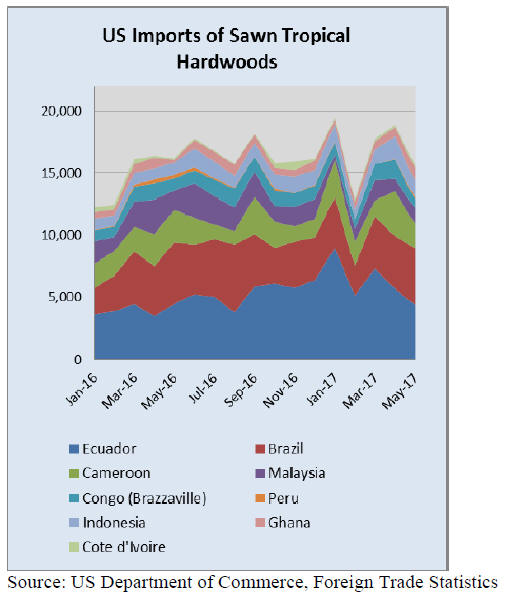|
Report from
North America
US ipe imports remain strong
The US imported 66,772 cu.m. of sawn temperate and
tropical hardwood in May, down 19% from April. The
value of imports declined by 9% to US$42.0 million.
Tropical sawn hardwood imports decreased 14% from
April to 19,170 cu.m. The value of tropical imports was
US$21.3 million and accounted for just over half of all US
sawn hardwood imports in May. The year-to-date volume
of imports was up 13% compared to May 2016.
Imports of most major tropical species were down in May
with the exception of ipe (3,640 cu.m.), keruing (1,119
cu.m.) and mahogany (698 cu.m.). Sapelli sawnwood
imports almost halved from April to 2,176 cu.m., but yearto-
date imports were higher than in May 2016.
US imports from Brazil increased to 4,586 cu.m. in May,
mainly due to higher ipe imports. Over 3,000 cu.m. of ipe
worth US$6.9 million were sold to the US market in May.
Indonesia and Malaysia each exported around 1,260 cu.m.
of sawnwood to the US in May. Keruing and meranti
imports from Malaysia increased from the previous month,
while imports from Indonesia declined. Imports from
Cameroon fell to 1,930 cu.m. in May due to lower
volumes of sapelli and acajou d¡¯Afrique.

Cameroon expands sapelli sawnwood exports to
Canada
Canadian imports of tropical sawnwood were worth
USUS$2.18 million in May, up 12% from April. Year-todate
imports increased 5% from May 2016.
The import growth was almost entirely in sapelli
sawnwood. While US imports of sapelli were down,
Canadian sapelli imports more than doubled from April to
USUS$783,259. Cameroon was the main source of sapelli
imports at USUS$675,939. The remainder of the sapelli
came to Canada via the US.
The second-largest import was virola, imbuia and balsa
combined, imported mainly from the US and a smaller
share from Brazil. No balsa sawnwood was imported
directly from Ecuador in May.
Canadian mahogany imports increased significantly in
May to USUS$145,435. The mahogany sawnwood came
from Mexico, Brazil and Cameroon.
Canada raises interest rates
Following the US Federal Reserve¡¯s interest rate hike in
June, Canada¡¯s central bank raised its rate for the first time
in seven years. The overnight lending rate was raised from
0.5% to 0.75%.
The central bank is optimistic about the Canadian
economy, which suffered after the oil price plunged in
2014 and 2015. Business investments, employment and
Canadian exports are up despite uncertainty around trade
negotiations with the US, including on sawn softwood.
The IMF¡¯s latest assessment of Canada¡¯s economy warned
of significant risks to Canada¡¯s economy, including a
sharp downturn in the housing market, high household
debt, US protectionism and a further decline in oil prices.
Preliminary anti-dumpting duties announced for Chinese
hardwood plywood
In June the US Department of Commerce announced its
affirmative preliminary determination in the antidumping
duty investigation of imports of hardwood plywood from
China.
The preliminary antidumping rates are 114.72% for
Shandong Dongfang Bayley Wood Co. Ltd., no duties for
Linyi Chengen Import and Export Co. Ltd., 57.36% for the
non-selected respondents eligible for a separate rate, and
114.72% for all other producers and exporters in China.
Cash deposits based on these preliminary rates are now
required, except for Linyi Chengen Import and Export Co.
Ltd.
The petitioners for the antidumping investigation are six
US hardwood plywood producers who form the Coalition
for Fair Trade in Hardwood Plywood. The American
Alliance for Hardwood Plywood criticized the duties, their
effect on American jobs, and the method by which the
duties were calculated. The Alliance represents American
importers, distributors and manufacturers of hardwood
plywood, along with other US companies.
In 2012 an investigation into dumping to hardwood
plywood from China was terminated. The termination was
appealed by the Coalition, but a federal judge upheld the
decision.
EPA withdraws formaldehyde emission rule for
extended compliance dates
The Environmental Protection Agency (EPA) has
withdrawn a rule that would have extended several dates
for wood composite producers to comply with
formaldehyde emission standards for composite wood
products.
The EPA had published the compliance extension rule in
May, but after receiving negative feedback from industry
the rule was withdrawn in July. The original, tighter
compliance dates published in the December 2016 final
rule on formaldehyde emissions will remain in effect.
The EPA also published a rule in July that would remove a
provision prohibiting early labeling of products compliant
with the formaldehyde emission standards.
The proposed rule would allow companies to voluntarily
label standard-compliant products as soon as compliance
is achieved. The rule will become effective in August,
unless negative feedback is received during the public
comment period.
https://www.epa.gov/formaldehyde/formaldehyde-emissionstandards-
composite-wood-products
|